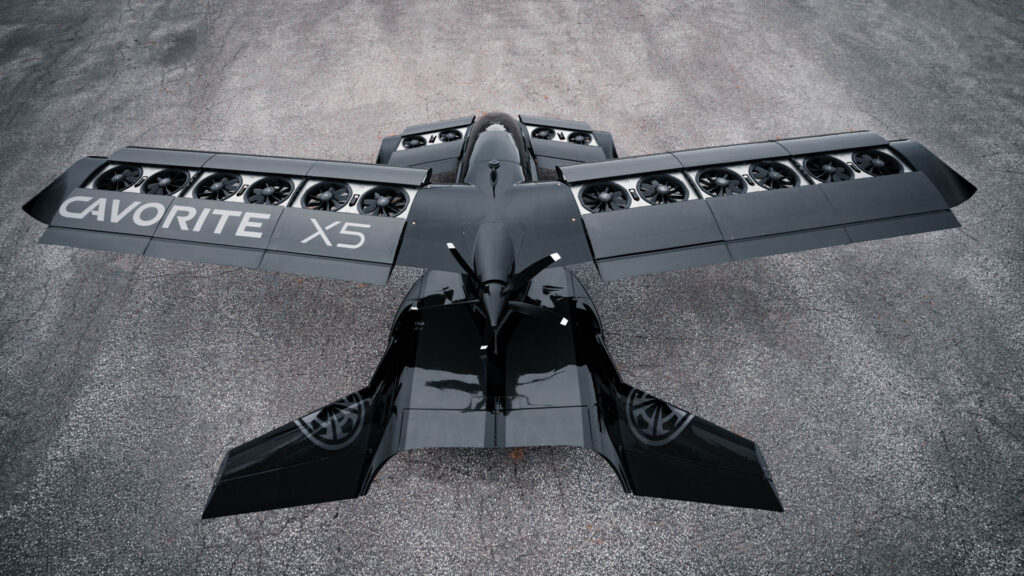As surprising it may seem to some tech skeptics, the emerging world of vertical take-off and landing (VTOL) aerial vehicles is, well, beginning to take off. You’ve likely seen footage of VTOL craft, which fly and land like helicopters but at greater speeds and lower operating costs. Due to the unique nature of this technology, VTOL businesses are turning to additive manufacturing (AM) to produce many of their parts. And why wouldn’t they? Their smaller-scale predecessors, quadcopters often rely on 3D printed components as well.
Horizon Aircraft’s VTOL Concept
Among the startups in the space is Canada-based Horizon Aircraft, founded in 2008 and focusing on hybrid electric VTOL vehicles. Its flagship craft is the Cavorite X5, featuring patented wings that open up to reveal series of fans for vertical takeoff and landing and close when performing traditional forward flight. When successfully built, Horizon’s vehicle will be used for such applications as Medevac, organ transport, disaster relief, regional cargo and passenger transport, and more.
Horizon has a lean Engineering team that achieves fast and efficient results by keeping CAD design, rapid 3D printed part prototyping, and quality validation in house. The firm won a U.S. Air Force Department of Defense AFWERX contract for R&D as one of only 11 companies to receive an award out of over 220 applicants. Currently, Horizon Aircraft have completed a fifty-percent-scale prototype that is successfully undergoing flight testing.
To get this far, Horizon Aircraft has had to rely heavily on 3D printing, both for design iteration and for obtaining parts that aren’t available off the shelf. The firm turned to one of the leading 3D printer solutions providers in Canada, CAD MicroSolutions.
3D Printing in Canada
Discussed in our PRO article on Canada’s AM ecosystem, CAD Micro is not only a reseller of 3D printers, but provides engineering, training, scanning services and more. It offers a curated selection of unique 3D printers, meaning that its solutions aren’t the run-of-the-mill machines you expect from resellers. Because the team is made up of experienced engineers and technology specialists, it is able to go beyond selling equipment and offer tailored solutions for businesses.
This is a unique advantage in Canada, where the 3D printing ecosystem is in a nascent stage but expected to boom along with the oil and gas industry there. There are few providers of such services at a quality level necessary for achieving the types of lofty goals pursued by Horizon Aircraft. Working with the Horizon team, CAD Micro directed it to the purchase of a FUNMAT PRO 410 from INTAMSYS, known for its comparatively low-cost, high-temperature extrusion 3D printers.
Bringing 3D Printing In-house
Because the FUNMAT PRO 410 is on par with outsourcing part production in terms of cost, Horizon was able to bring AM in-house without the fear that intellectual property would have to leave the workshop. As an open materials system, the printer allowed the team to print with HTN-CF for 80 percent of the functional printed parts on the aircraft. This included components as large as 12 inches in diameter, thanks to the large, heated build plate and chamber of the machine. The FUNMAT PRO 410s industrial build quality also enabled non-stop production.
In total, Horizon Aircraft printed over 780 parts for their aircraft, each of which has undergone several iterations. This includes modifying impellers to optimize noise level thrust and motor compatibility, for instance.
Physical design iteration is typically an extremely costly and time-consuming process, making the barrier to entry for new aircraft manufacturing even higher than it might otherwise be. However, the FUNMAT PRO 410 made it possible to produce a functional prototype in a significantly shortened timeframe, with each individual component optimized more thoroughly, cost-effectively, and quickly compared to traditional manufacturing methods.
The VTOL Test Flight
The company just published footage of the first test flight for its half-scaled prototype craft. The vehicle measures 15 feet long, weighs almost 500 lbs, has a 22-foot wingspan and is capable of reaching over 175 mph. The video showcased the ability of the vehicle to perform a full hover at just 65 percent power, with 20 percent of its fans disabled for system redundancy testing.
While Horizon Aircraft may be just one among a number of startups working in this exciting, new sector, it has proven to have a leg up through a combination of engineering skill and low-cost, in-house AM. Having successfully complete Phase 1 of the AFWERX contract and a scale prototype of the Cavorite X5, Horizon will be onto the next project on the horizon: building the full scale vehicle.
Subscribe to Our Email Newsletter
Stay up-to-date on all the latest news from the 3D printing industry and receive information and offers from third party vendors.
Print Services
Upload your 3D Models and get them printed quickly and efficiently.
You May Also Like
The Dental Additive Manufacturing Market Could Nearly Double by 2033, According to AM Research
According to an AM Research report from 2024, the medical device industry, specifically in dentistry, prosthetics, and audiology, is expected to see significant growth as these segments continue to benefit from...
Heating Up: 3D Systems’ Scott Green Discusses 3D Printing’s Potential in the Data Center Industry
The relentless rise of NVIDIA, the steadily increasing pledges of major private and public investments in national infrastructure projects around the world, and the general cultural obsession with AI have...
AM Research Webinar Explores Continuum’s Sustainable Metal Additive Manufacturing Powders
Metal additive manufacturing (AM) powder supplier Continuum Powders is working to develop solutions that empower industries to reduce waste and optimize their resources. An independent life cycle assessment (LCA) of...
3D Printed Footwear Startup Koobz Lands $7.2M in Seed Round
California-based Koobz is focused on reshoring the U.S. footwear supply chain with advanced manufacturing processes, including 3D printing. The startup just announced that it has added $6 million to its...





































